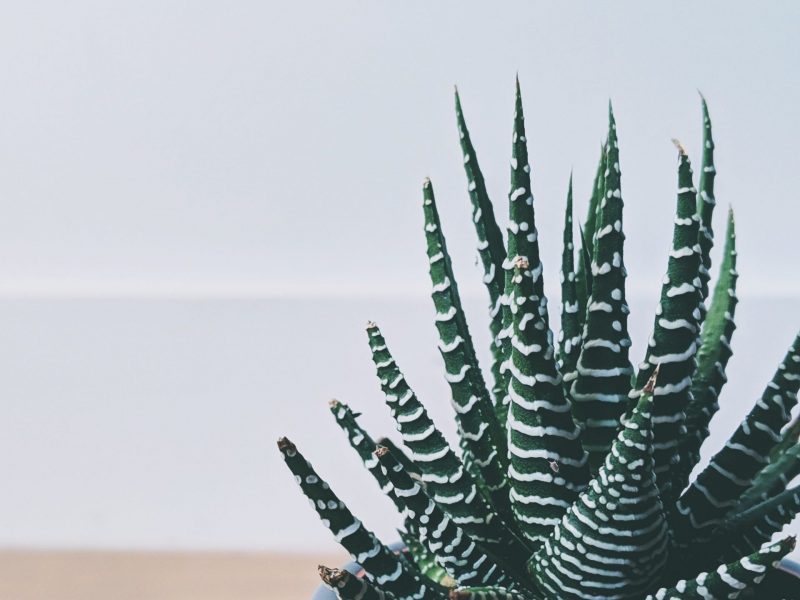
Loved for their white and dark green Zebra-style stripes, Zebra Cacti are beautiful small succulent plants that look a little like the popular Aloe Vera. Whilst they can be pretty low maintenance, it can happen sometimes that they start to develop brown leaves.
This can either occur from the tips of the leaves downwards or browning across an entire leaf or section of your plant. If this is happening to your Zebra Cactus, then it definitely signals that something isn’t right with either the environment in which your plant is living or the care routine it’s receiving.
Before you give up on your Zebra Cactus and become defeated by the brown leaves, let us take you through each of the causes of browning so you can figure out what is happening to your plant as well as fix the issue and prevent it from harming your plant again in future.
Causes of Brown Leaves on a Zebra Cactus
Underwatering can cause brown leaf edges and tips
If the leaves on your Zebra Cactus have turned light brown and are quite dry, then it might be a lack of water that is causing the issue. Although Zebra Cacti don’t like sitting in puddles of water as they are succulent plants, they can’t go without a drop of water for too long. Consistent underwatering will cause them to develop brown leaves from the tips and edges inwards.
The best way to diagnose this issue is to remove your plant from its pot and inspect the soil. If the potting mix is very dry and powdery, and you can see that some of the roots have started to look a little crispy, then your Zebra Cactus will need more moisture. Dry roots do suggest that the issue has been going on for some time so you may need to be a little patient in the recovery process.
Other ways to diagnose underwatering as a cause of the brown leaves is to either use a moisture meter or the chopstick method. A moisture meter is definitely the most precise way to keep track of when your plant needs watering and they are pretty affordable too.
Slowly reintroduce water to your plant over the course of a week but be careful not to go the other way and start overwatering your Zebra Cactus as this can also cause brown leaves (more on that below). If you drown them in water all at once then this sudden change in their environment might actually shock your plant.
Overwatering can also cause brown foliage
If you notice that your Zebra Cactus is developing dark brown leaves that are quite droopy and soft to touch, then it is probably too much water that has caused this.
Overwatering can very quickly lead to root rot as Zebra Cacti have very shallow and delicate roots. Alongside browning leaves, it can also cause the plant to become unstable and soft. If not caught quickly, this can mean your plant will not be able to survive.
If you think you might have overwatered your Zebra Cactus it’s important to check the soil right away and change it out completely if it is waterlogged. You may be tempted to wait for the potting mix to dry out on its own. However, we strongly recommend against this as even a few more days of sitting in wet soil can cause a lot of damage to the root system, leading to more brown leaves and potentially even other problems. This is why you need to act quickly once the issue is spotted and diagnosed.
Watch out for hotspots and heat stress
If your Zebra Cactus is exposed to really hot temperatures over a long period of time, this can dry out the plant and cause brown leaves. Although Zebra Cacti are the perfect windowsill plant when it comes to their size, be careful if the window is getting too much direct sunlight as this can cause a hotspot to form by the window.
But it’s not just hotspots caused by the sun that you need to be careful of. Brown leaves can develop if your Zebra Cactus is too close to radiators, heating vents or even cookers.
Using a temperature monitor can also help you avoid this problem and keep track of any fluctuations. They are great at allowing you to find the perfect place for your Zebra Cactus and be aware that you may need to move it around throughout the year.
Sunburn can also turn the leaves brown
If your Zebra Cactus is receiving too much bright direct sunlight each day you may start to notice yellow/brown patches appearing on the leaves. This is actually a slightly different point to the hotspots that we mentioned above because the warmth of the sun will dry out the plant, but intense direct sun rays can actually burn the plant.
When intense sunlight scorches your Zebra Cactus, it can cause brown and yellow patches, more of which will of course be on the side that faces the window.
As they are small succulents, a lot of plant parents like to keep them on the windowsill, which for a lot of the year is no problem at all. However, you’ll need to be more cautious of leaf burn during summer.
Luckily you don’t need need to worry much about sunburn in winter as the sun is a lot weaker and there are generally fewer hours of daylight. So if this is happening in the depths of winter, you can likely rule out sunburn as a possible cause.
You can use a light monitor to figure out if your plants are getting the right amount of sunlight. We love this one which is available on Amazon here.
How to Treat and Prevent Brown Leaves on a Watermelon Peperomia
Adjusting your watering routine
Make sure to check the moisture in the soil before you water your Zebra Cactus so that you can be sure it has dried out.
The easiest way to check this is by digging your finger into the top two centimetres of the soil to see how damp it is. We also recommend picking up your Zebra Cactus before and after watering. This should give you a feel for when your Zebra Cactus might need a little more water, simply by giving them a lift.
If you aren’t really sure about how to know if your Zebra Cactus needs watering, we recommend picking up a moisture meter. They are super affordable and tell you how much moisture is in the soil.
There are two factors that you want to think about when it comes to adjusting how you water your Zebra Cactus. How much water you give your plant each time, and how often you water it in the first place. As succulents, Zebra Cacti prefer to be watered deeply but not that often, rather than constantly being given a little bit of water which never allows the potting mix to dry out.
Switch to a well-draining soil
Another thing that you can do to prevent watering issues (and subsequent problems such as brown leaves), is to replace the soil with a succulent and cacti mix.
These potting mixes have perlite and other ingredients that aid drainage and aeration in the soil. This allows water to flow through the soil easily and avoids problems caused by waterlogged soil and root rot.
Adjust your plant’s positioning
When it comes to hotspots and sunburn, it’s important that you are relocating your Zebra Cactus so that it’s not receiving too much intense summer sun or too close to radiators etc that might be drying out the plant.
Another thing to consider doing is having a winter spot and a summer spot for your Zebra Cactus (and other houseplants too!). This is because environmental factors such as temperature and sunlight change dramatically throughout the year. A spot that might be perfect for your plant in winter might be getting way too much sunlight during summer or the other way around.
This is why it’s important to be measuring the light level and temperature across your home to find the right place for your plant and avoid more brown leaves in future.
Monitor the environment
The best way to prevent brown leaves from developing on your Zebra Cactus in future is to monitor any changes in the environment and act before they cause harm to your plant.
Ensure that you are tracking temperature so that you can spot any cold drafts or hotspots that might crop up from time to time. Try to get a thermometer that has a setting that saves the hottest and coldest temperatures over the past 24 hours. This will allow you to spot any fluctuations at night or at times when you are out and about.
Removing the Brown Leaves on a Zebra Cactus
Now that you have (fingers crossed) diagnosed and treated the issue, you might be left wondering what to do with the parts of your plant that have already turned brown.
Unfortunately, once any part of the plant has turned brown, there is no way to reverse this. This is why we recommend removing the parts of the plant that are majority brown. They are dying and will be consuming some of your plant’s energy for no benefit. By removing them, you are allowing your Zebra Cactus to focus entirely on new healthy leaves.
If there are parts of your plant that only have a small brown spot or patch, then we don’t recommend removing these. They will still be beneficial to your plant and removing too much of the overall plant will hinder its overall health and growth ability.
Frequently Asked Questions
Why is my Zebra Cactus turning brown?
Underwatering, overwatering and temperature issues are the most common reasons why Zebra Cacti develop brown leaves. Check the potting mix and the root system to determine whether watering issues are to blame. You also want to monitor the temperature and light level around your plant to spot any extremes.
How to fix a brown Zebra Cactus?
If watering issues are causing the brown leaves, then you want to adjust how frequently you are watering your Zebra Cactus. You should be leaving enough time for the potting mix to fully dry out but not for extended periods of time.
If sunlight and temperature issues are the cause of the brown leaves, then relocating your Zebra Cactus will be high priority.
Why does my Zebra Cactus have brown leaf tips?
Brown leaf tips on a Zebra Cactus suggest that it is being underwatered. Luckily, if only the tips are brown then the issue won’t be too advanced and you should be able to solve it quickly by adjusting your watering routine.
You should remove any parts of your Zebra Cactus that are completely brown. However, if there are a few brown spots on a leaf, then these should not be removed as they are still extremely valuable to the photosynthesis process.
Those are the most common problems that tend to cause a Zebra Cactus to develop brown leaves, spots or tips. To diagnose the issue, start by ruling out any watering problems as these are the most common.
Then to prevent the issue (and others) from happening again in future, it’s important to begin giving your plant a thorough check-up about once a month. Look over the leaves, soil and even sometimes the root system to see if you can spot any early warning signs. Spotting issues as early as possible will give you the best chance at treating them and reviving your plant.
Consistently monitoring environmental factors such as temperature and light level, as we mentioned earlier, along with routine check-ups is the best way to prevent the issue from happening again.
Check out our Zebra Cactus care guide for more information on how to best care for your plant.














